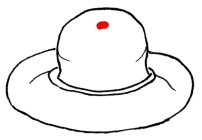WoRMS taxon details
Diadematacea
152528 (urn:lsid:marinespecies.org:taxname:152528)
Duncan, 1889 (emend. Mongiardino Koch et al., 2022)
accepted
Superorder
- Order Diadematoida
- Order Micropygoida
marine, brackish, fresh, terrestrial
recent + fossil
Not documented
Status First usage of this group by Durham & Melville (1957) includes Diadematoida, Echinothurioida and Pygasteroida, but was used...
Status First usage of this group by Durham & Melville (1957) includes Diadematoida, Echinothurioida and Pygasteroida, but was used with different content since (compare Kroh 2020). Usage of this group for the clade discovered by Mongiardino Koch et al. (2018) diadematoids, pedinoids, and echinothurioids might not be in the interest of clarity of application, wherefore Kroh (2020) suggested that Aulodonta Jackson, 1912 to be the best (and oldest) available name for the group. The taxonomically expanded analysis of Mongiardino Koch et al. (2022) confirmed the hypothesis of Kroh (2020) that the clade would also include aspidodiadematoids and micropygoids, the latter of which were shown to be the sister group of diadematoids. Therefore, Mongiardino Koch et al. (2022) proposed usage of Diadematacea for diadematoids + micropygoids. [details]
Kroh, A.; Mooi, R. (2025). World Echinoidea Database. Diadematacea. Accessed through: World Register of Marine Species at: https://www.marinespecies.org/aphia.php?p=taxdetails&id=152528 on 2025-05-12
Date
action
by
![]() The webpage text is licensed under a Creative Commons
Attribution 4.0 License
The webpage text is licensed under a Creative Commons
Attribution 4.0 License
Nomenclature
basis of record
Kroh, A. & Smith, A.B. (2010): The phylogeny and classification of post-Palaeozoic echinoids. Journal of Systematic Palaeontology, 8/2: 147-212., available online at http://www.informaworld.com/openurl?genre=article&issn=1477-2019&volume=8&issue=2&spage=147 [details]
Taxonomy
taxonomy source
Mongiardino Koch, N.; Coppard, S. E.; Lessios, H. A.; Briggs, D. E. G.; Mooi, R.; Rouse, G. W. (2018). A phylogenomic resolution of the sea urchin tree of life. <em>BMC Evolutionary Biology.</em> 18(1)., available online at https://doi.org/10.1186/s12862-018-1300-4
page(s): 11 [details]
status source Kroh, A. (2020). Phylogeny and classification of echinoids. <em>Developments in Aquaculture and Fisheries Science.</em> 1-17., available online at https://doi.org/10.1016/b978-0-12-819570-3.00001-9
page(s): 4-5 [details] Available for editors [request]
[request]
page(s): 11 [details]
status source Kroh, A. (2020). Phylogeny and classification of echinoids. <em>Developments in Aquaculture and Fisheries Science.</em> 1-17., available online at https://doi.org/10.1016/b978-0-12-819570-3.00001-9
page(s): 4-5 [details] Available for editors
Other
context source (PeRMS)
Solís-Marín, F. A.; Alvarado, J. J.; Abreu-Pérez, M.; Aguilera, O.; Alió, J.; Bacallado-Aránega, J. J.; Barraza, E.; Benavides-Serrato, M.; Benítez-Villalobos, F.; Betancourt-Fernández, L.; Borges, M.; Brandt, M.; Brogger, M. I.; Borrero-Pérez, G. H.; Buitrón-Sánchez, E.; Campos, L. S.; Cantera, J.; Clemente, S.; Cohen-Renjifo, M.; Coppard, S.; Costa-Lotufo, L. V.; del Valle-García, R.; Díaz, Y.; Díaz de Vivar, M. E.; Díaz-Martínez, J. P.; Durán-González, A.; Epherra, L.; Escolar, M.; Francisco, V.; Freire, C. A.; García-Arrarás, E.; Gil, D. G.; Guarderas, P.; Hadel, V. F.; Hearn, A.; Hernández, J. C.; Hernández-Delgado, E. A.; Herrera-Moreno, A.; Herrero-Pérezrul, M. D.; Hooker, Y.; Honey-Escandón, M. B. I.; Lodeiros, C.; Luzuriaga, M.; Manso, C. L. C.; Martín, A.; Martinez, M. I.; Martínez, S.; Moro-Abad; Mutschke, E.; Navarro, J. C.; Neira, R.; Noriega, N.; Palleiro-Nayar, J. S.; Pérez, A. F.; Pérez-Ruzafa, A.; Prieto-Rios, E.; Reyes, J.; Rodríguez, R.; Rubilar, T.; Sancho-Mejía, T.; Sangil, C.; Silva, J. R. M. C.; Sonnenholzner, J. I.; Ventura, C. R.; Tablado, A.; Tavares, Y.; Tiago, C. G.; Tuya, F.;Williams, S. M. (2013). Appendix. <em>In: J. J. Alvarado & F. A. Solís-Marín (eds), Echinoderm Research and Diversity in Latin America.</em> pp. 471-510. Springer; Berlin & Heidelberg. page(s): 543-654. [details]
From editor or global species database
Status First usage of this group by Durham & Melville (1957) includes Diadematoida, Echinothurioida and Pygasteroida, but was used with different content since (compare Kroh 2020). Usage of this group for the clade discovered by Mongiardino Koch et al. (2018) diadematoids, pedinoids, and echinothurioids might not be in the interest of clarity of application, wherefore Kroh (2020) suggested that Aulodonta Jackson, 1912 to be the best (and oldest) available name for the group. The taxonomically expanded analysis of Mongiardino Koch et al. (2022) confirmed the hypothesis of Kroh (2020) that the clade would also include aspidodiadematoids and micropygoids, the latter of which were shown to be the sister group of diadematoids. Therefore, Mongiardino Koch et al. (2022) proposed usage of Diadematacea for diadematoids + micropygoids. [details]

